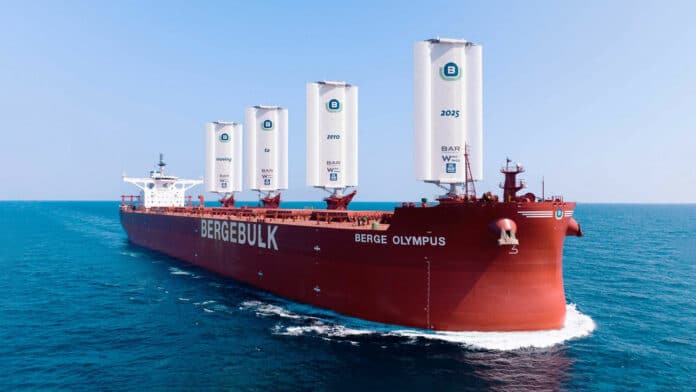Singapore-based Berge Bulk has launched its Newcastlemax bulker, Berge Olympus, with four retrofitted BARTech WindWings by Yara Marine Technologies that use wind power to reduce fuel consumption and CO2 emissions.
The WindWings installation is part of Berge Bulk’s ambition to become carbon neutral by 2025 and marks the Berge Olympus as the “world’s most powerful sailing cargo ship.”
The Berge Olympus is equipped with four WindWings, which are large and streamlined sails that measure 20 meters in width and 37.5 meters in height, which is taller than a 10-story building. The total surface area of the four wings is 3,000 m2, which is more than three times the surface area of the wings of an A380 airplane.
The wings are fitted to the deck of the vessel but can be folded away at the touch of a button. Also, the system is automated, which means it is easy and safe to operate without the need for additional crew.
The WindWings system combines dynamic multi-element wings and advanced route optimization to harness the power of the wind to reduce the vessel’s fuel consumption by 6 tonnes per day on an average worldwide route. This also means that the Berge Olympus will reduce CO2 emissions by approximately 19.5 tonnes per day, contributing to the environmental sustainability of Berge Bulk.
With these fuel savings and CO2 reductions, Berge Bulk is evaluating the potential of installing WindWings on more of its vessels that operate on wind-friendly routes.
The WindWing technology actively supports the industry in its mission to reduce the carbon intensity of international shipping by at least 20% by 2030 and 70% by 2040, reflected in the new IMO regulations. Berge Bulk’s WindWings project shows its commitment to environmental sustainability and technological innovation.
In addition to the installation of the WindWings, Berge Olympus has also been retrofitted with a shaft generator system, which is driven by the main engine to supply electric power to the vessel. With a 1MW capacity, it is sized to eliminate the need to operate auxiliary engines while at sea and further reduces fuel and emissions.
Berge Bulk is committed to achieving carbon neutrality by 2025 as part of the global effort to meet future decarbonization goals. The company has implemented a four-pillar plan to reduce its carbon footprint through safe, efficient, and sustainable shipping. The plan, dubbed the “Marshall Plan,” includes enhancing fleet efficiency, adopting the latest maritime technology, testing new fuels, and investing in carbon capture.
One of the key technologies that Berge Bulk has adopted is WindWings, a result of years of research by naval architect BAR Technologies. WindWings can help vessel owners quickly retrofit new technologies to make a rapid and profound difference in the climate impact of their fleet.
“At Berge Bulk, we are constantly striving to enhance our efficiency and reduce the environmental impact of our existing fleet. From 2008 until today, we have achieved a remarkable 46% reduction in our CO2 emissions per tonne mile, already surpassing the 2030 IMO target for reducing carbon emissions intensity,” said James Marshall, Chief Executive Officer of Berge Bulk, in the press release.
